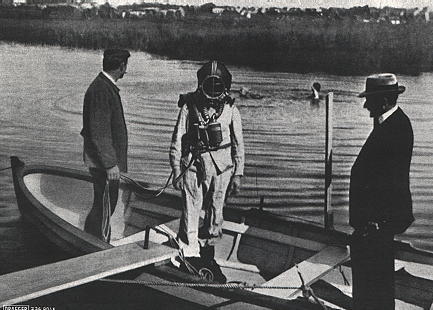
First trials in 1911. Diver with smoke helmet and breathing bag. On the right: Bernard Dräger
Introduction
Hermann Stelzner was born on the second of august 1884 in Ahrensbök Germany. He studied to be a "machine building" engineer and worked for a German railroad company and a shipping company. In the spring of 1906 he joined the Dräger company and became the personal assistant to doctor Bernard Dräger. In those days the Dräger company was involved in the gas diving business. They had nothing to do with underwater diving and developed products to clean toxic air and breathing apparatus to work in toxic environments. Bernard soon trusted Hermann with all his alcali secrets.
Tauchretter
In the summer of 1910, a French submarine named "Pluvoise" had an accident and all the sailors on board drowned. Dräger decided that this should never happen to a sailor again and asked Stelzner to help him develop a device for sailors to escape from submarines. In those days the Tauchretter (diver saver) subject was very new, also to English developers. Later, this turned out to be the start of a long and very successful career for Stelzner in the diving industry. After the tauchretter Hermann became involved in the development of general diving technique, hose less oxygen diving apparatus, breathing gas regeneration and further development of surface supplied air diving.

First trials in 1911. Diver with
smoke helmet and breathing bag. On the right: Bernard Dräger
In his work Stelzner was often supported by his friends and diving pioneers Max Valentiner, Robert Bräutigam and Arnold Gottsleben. The four of them carried out many tests that were not always without danger.
|
|
|
|
Hermann ready to go down with one of the first versions of the tauchretter in 1911 |
Trials under the ice in 1911 with the second test version of the DM 20 mixed gas hoseless apparatus. Gottsleben would sometimes stay down for 4 hours to see how long the regeneration material would last |
|
|
|
|
Tauchretter model 1911 with divingsuit and rubber helmet. Not a noseclip type but breathing through the helmet |
Tauchretter model 1912 with diving suit and rubber hood. No helmet breathing |
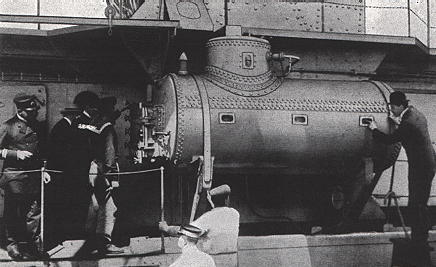
Trials in the tank on board the
"Vulcan" in Kiel Germany 1912
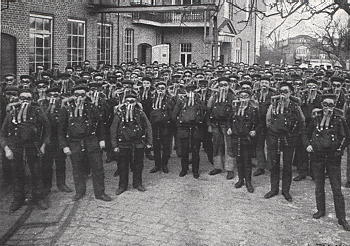
Team of workers checking
tauchretters in the Dräger factory in march 1912.
Before the tauchretters would be delivered to the navy, they were always
thoroughly tested.
Hoseless diving apparatus
In 1912 the first hose less diving apparatus came on the market. It was based on an oxygen regeneration system. Many tests were carried out in lakes and harbors, in strong current and under ice in depths up to 30 meters. The German as well as many other navies started using this equipment. Visit the "Different ways of air supply section" to learn more about this apparatus.
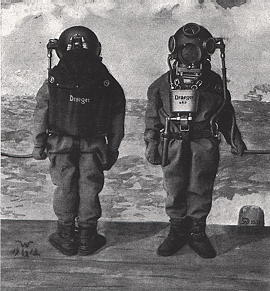
Front and rearview of the hose less diving apparatus model 1912
Underwater sledge
Together with Valentiner, Stelzner developed a fantastic device called the underwater sledge. The sledge was pulled by a boat and allowed the diver (dressed in hose less diving apparatus) to search large areas under water. This construction was used many times to trace lost torpedoes, submarines, mines etcetera. The diver held a lever in his hand that was used as a depth helm. In this way the diver was able to avoid plants, rocks etcetera.
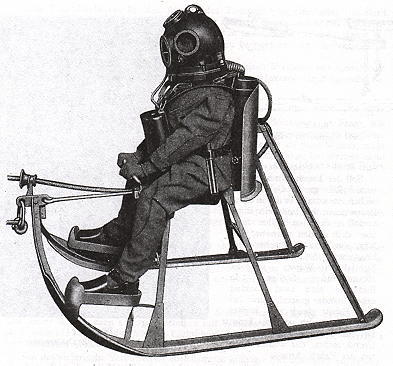
Wartime
When WW1 started Stelzner also became involved. He developed and build gasmasks, tauchretter and hose less diving apparatus, mine suits and diving bells.
Other purposes of his knowledge
Stelzner knowledge of breathing physiology was also used in other fields. He also developed air regenerating systems for great height. Many people used this device, including Professor Piccard who reached 15718 meters in his balloon on may 27 1931. Stelzner also developed an oxygen breathing device for working on great heights.
Besides this the hose less diving apparatus and the tauchretter systems kept improving under Stelzner.
|
|
|
|
Arnold Gottsleben wearing a tauchretter model 1934 |
Front and rearview of the hose less diving apparatus model 1934 |
Worldwar II
During the second worldwar, Stelzners knowledge of the air regenerating business was used again. He developed gasmasks for men, horses and dogs. He developed air regenerating and cleaning systems for bomshelters.
Stelzner lived for and on his job. In the end he collapsed behind his desk in the Dräger factory. A day later, on the 19th of October 1942, he died.
Stelzners' definition of divers from 1931
| "Divers are men with great muscular power and healthy organs. Divers are men with high mental power, sense and moral. They have to stand up to many different dangers, their perception and presence of mind have to be high. But to deliver useful and efficient diving work is in fact also the art of the diver". |
|
Source: Dräger Company, Lübeck Germany